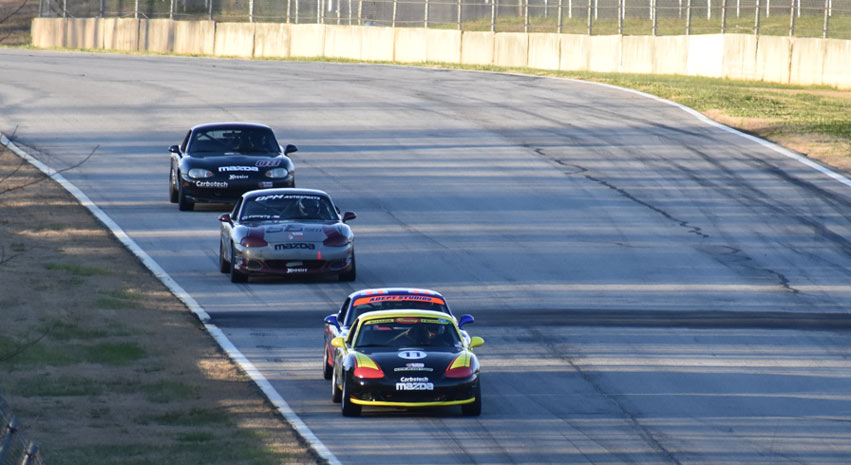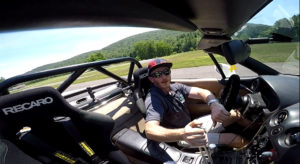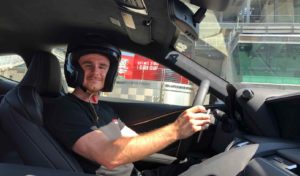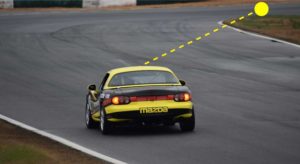In one of my previous articles (minimum corner speed location) I discussed how going slow at a specific, premediated point in the turn can maximize your overall lap time.
In this article we will be going through the “HOW” for when it comes to slowing down for a corner. I’ve broken down the different ways you can slow down into 5 different categories:
- Straight Line Threshold Braking
- Straight Line Partial Braking
- Trail Braking
- Brake & Turn
- Throttle Lift
It’s important to understand the different ways we can slow down for a corner. By understanding each of these and their unique advantages and disadvantages, the performance driver can then prescribe themselves the slowing strategy that is particular to the corner type. This will in turn optimize the car’s handling and make it easiest to “work with the car” rather than fight with it through a turn.
Let’s discuss the different ways to slow down using the brake pedal first.
Slowing Down With The Brake Pedal
If you’ve hung around the race track long enough you’ve undoubtedly head of the term “trail braking.”
The term is often described as “turning with the brake on.” While this isn’t exactly the wrong way to describe trail braking, it is actually only 1 of the 3 different ways we can use the brake pedal. Therefore, we can either be increasing brake pressure, maintaining brake pressure or releasing brake pressure while using the brakes to slow down. There are no other possible ways to be touching the brake pedal. When you work under the assumption that there’s some steering input in the car, I define your braking as either “trail braking” or “braking and turning.”
Trail Braking – Any decrease in brake pressure with steering input in the car.
Braking & Turning – Any application of brake pressure or brake pressure maintenance with steering input in the car.
Now that we’ve established the two different ways to slow down with the brake pedal, let’s take a look at when you’d want to apply each of the techniques and why.
What Trail Braking Actually Is & Why Do it?
As defined above, I define trail braking as any reduction in brake pressure with steering input in the car. When you release the brakes, there are two main things that happen that are important to note.
- The load shifts front to back.
- In order to release the brakes, you must have first pressed them. Therefore, the suspension and tires must have loaded abnormally toward the front. When you eventually release the brakes, you are transitioning the load from “abnormally to the front” back to the “static resting state” of the suspension, longitudinally speaking.
- You are asking the car to turn more.
- The more you release the brake, the more grip the car has available for turning capacity. When you set your steering wheel into the corner and you’re still on the brakes, the steering angle that’s required to get to the apex is based on the amount that you’re still on the brakes. Consequentially, The more you’re on the brakes, the more you’re forcing the car to go straighter and seek a larger radius. When you eventually release the brakes, the car will turn more and seek a tighter radius because it no longer is being asked to slow down as well. (This is called Trail Brake Oversteer and is why you see cars often spin out on brake release.)
When I trail brake, I’m only thinking about these two consequences that are generated from releasing the brake with steering input in the car.
Trail braking is useful because it allows us to turn the car in with more load towards the front than what we would have had if we didn’t turn in on the brakes whatsoever. The catch is, that when we start turning into the corner, we must give up a proportionate amount of brake in order to allow the car to turn. Therefore, we are obeying the 100% rule.
100% Rule – The tire only has 100% total grip. That grip can be divided up between braking and turning, accelerating and turning, braking only, accelerating only or cornering only. You can use any % you want to do each task, but they can only add up to 100%. Over 100% and either the front or rear (or both) will seek the radius that the speed dictates. Ex: Accelerating out of a corner, you can use 70% throttle, so long as your steering is at a maximum of 30%.
Trail braking is used in specific corner types.
One example would be a slow, tight hair pin corner. Since the duration of the turn is so long, the longer you can keep the load over the front tires, the better. We know we want to exaggerate our brake release as far into the turn as possible to keep the load on the front. We will use trail braking here by only giving up brake pressure in proportion to the amount of steering we take out.
Trail braking must be executed properly and utilized in the proper type of corner for it to be fast and feel right. It’s an art to say the least, and it separates the best from the second best!
Braking & Turning
As defined above, Braking & Turning is defined as any application of brake pressure or maintenance of brake pressure.
When you are already turning and hit the brakes, there are two things that happen.
- The load shifts from the back to the front.
- If you turn in “not on the brakes” and then you go to the brakes, the load will shift forward.
- You are asking the car to turn less.
- The tires were happily doing their own thing on their prescribed radius, but when you went to the brakes you asked them to take on another job. Any amount of brake that you sub-sequentially add is another degree of radius the car will go straight. Consequently, the more steering it will require to maintain that same arc. Eventually, once you go over 100% total grip of the tire, the car will simply go the radius the speed dictates.
Braking and Turning is used in a scenario where you are forced into having steering input on initial brake. This would happen in most decreasing radius corners where you can enter the turn fairly fast but need to slow down more as you get further into it.
Straight Line Braking
Up until now we’ve been discussing the different types of braking with presumed steering input in the car. But what about straight line braking? I like to divide straight line braking into 2 different categories.
Threshold Braking – Sustaining a brake pressure that results in the highest possible (G) force. This is either right before a tire locks up or right before the ABS system kicks in.
Speed Adjustment Braking – Braking that isn’t full force but rather only the amount of brake that is necessary to slow down for the corner.
A fast, constant radius turn typically benefits from straight line braking. This is because it’s good to turn in with the car predictably balanced. In this example, we do whatever amount of slowing we need to do in a straight line before the corner. As a result, we ensure we are back on maintenance throttle by the time we turn in, balancing out the platform of the car and making it nice and stable at turn in.
Throttle Lift
Finally, the last type of slowing down is the one that is just done with a throttle lift. This would be a corner that doesn’t require a big speed adjustment.
A speed adjustment done via only a throttle lift (and no brakes) will have the same effect on load transfer as straight line braking and trail braking. However, it will be less severe because the brake would shift the load further forward than the throttle lift would.
Prescribe Yourself A Way To Slow Down For Each Corner
Now you know the 5 different ways to slow down. But, how do you tell which type of slowing to use for which type of corner? Easily, using my free download below which shows you the best way to slow down for the most common corner types.
FREE PDF GUIDE
THE BEST WAY TO SLOW DOWN FOR THE MOST COMMON CORNER TYPES
You’ll also receive updates and wisdom twice per month. Unsubscribe at any time. We’ll never share your information.
This is where it gets tricky, because it’s not just about the shape of the corner that will determine this. It’s also about any pavement changes, camber changes, elevation changes, or changes in condition. All of these things are variables that determine how you want to slow down and there is no cut and dry solution.
However, generally speaking, we can narrow this down to a few principles.
The faster the corner the less trail braking you will use. The slower the corner, the more trail braking you will use.
This is because in a quick corner you want that balanced platform. In contrast, in a slower, sharper corner you usually want to load over the nose longer to get the car turned.
Another way to choose how to slow down will depend on how your car is handling. If your car is very loose, you will benefit better from a straight-line speed adjustment. On the contrary if your car has a lot of under steer, you will benefit from more trail brake. This keeps the load on the nose for a longer period of time.
The performance driver should always be thinking about the effect that load transfer has on the contact patches (where the rubber meets the road.)

ABOUT THE AUTHOR
JONATHAN GORING
From 2006 Skip Barber National Champion to 2015 Spec Miata SCCA Runoffs Champion, and with the 2008 IMSA Lites title in between, I’ve been in the racing scene for quite some time. I’ve been fortunate to race against (and beat sometimes) the best drivers in the world currently racing in various top level motorsports.
I’m very passionate about the art/science of performance driving and want to share that passion with you.
WANT TO DRIVE FASTER THAN EVER?
Join my email list for twice monthly articles, driving tips, exclusive announcements on new things I’m working on and wisdom delivered straight to your inbox! You can unsubscribe at any time.




